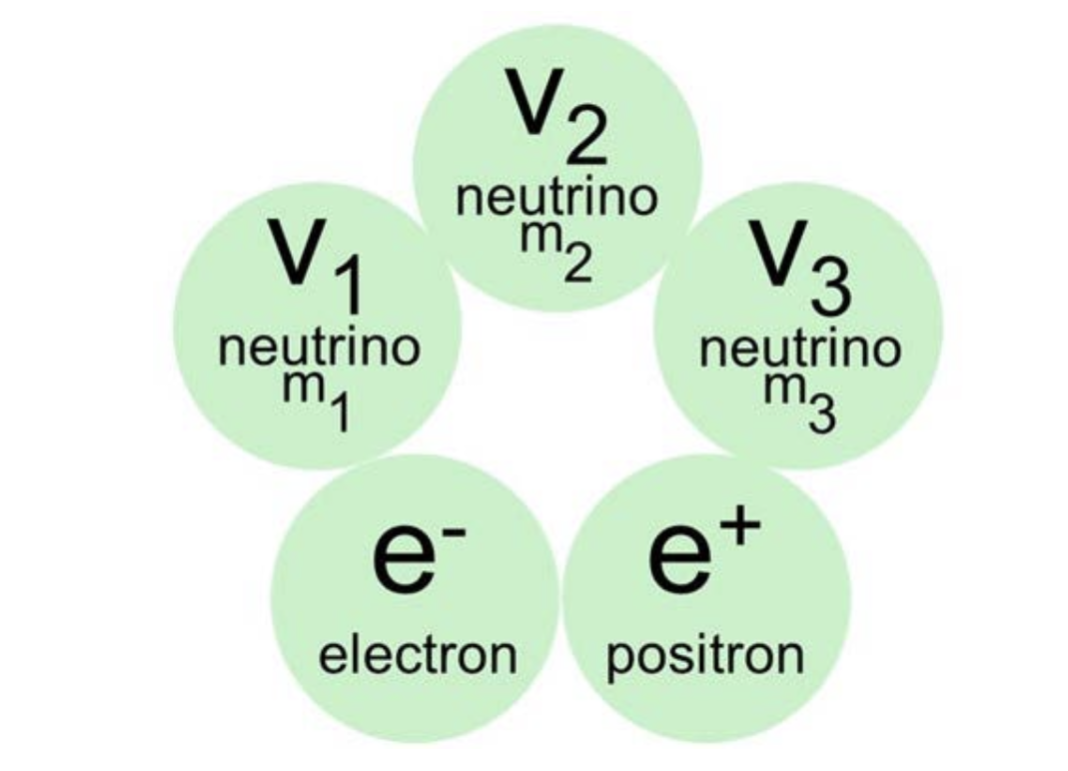Constantinos G. Vayenas from the University of Patras, Academy of Athens explores how positron and electron catalysis of neutrino hadronization has created the mass of our universe
For the first time, the mechanism of the violently exothermic formation of hadrons (e.g., neutrons and protons) from ambient neutrinos has been presented in several recent publications, (1 – 4) including a Springer Nature book. (5)
This violently exothermic reaction has led to the generation of all hadronic matter from only five elementary particles: The positron, the electron, and the three neutrinos (Fig. 1).
Here we discuss the basic thermodynamics and kinetics of this positron and electron-catalyzed neutrino hadronization.
The creation of quarks and hadrons from fast relativistic neutrinos via their strong gravitational attraction has been recently shown to be the dominant mechanism of hadronic mass generation from neutrinos. (5)

According to this mechanism (Fig. 2), neutrinos are the reactants, positrons/ electrons are the catalysts, and hadrons are the products of this extremely important violently exothermic reaction, which leads to circular lepton orbits around positrons and electrons. The neutrino speeds in these orbits easily reach Lorentz factor γ values as high 1010, so that the relativistic masses, γmo where mo is the rest neutrino masses of 10-2 eV/c2, easily reach the range of hadron masses, i.e. of 109 eV/c2. This very efficient neutrino hadronization mechanism had totally escaped scientific scrutiny before the development of the Rotating Lepton Model of Elementary Particles (RLM).(1-5)
The RLM combines the equation of motion(1-4)of the rotating relativistic neutrinos of rest mass in a simple manner, mo, i.e.

where γ = (1-v2/c2)-1 is the Lorentz factor, γ3mo is the gravitational neutrino mass, (5) and r is the rotational radius. Upon adding in the model the de Broglie equation of Quantum Mechanics, (6) i.e.

and the energy conservation equation, i.e.

Where mn is the mass of the hadron n formed, and γ3mo is the gravitational mass of the relativistic neutrinos. These relativistic neutrinos are the so-called quarks. (5)
A combination of equations (1), (2), and (3) leads to

Using mo=0.0437 eV/c2 (7) and mPl=1.221.1028 eV/c2, equation (4) yields m=939.565MeV/c2, which is in excellent agreement with the experimental neutron mass.
When these three highly relativistic neutrinos get trapped in a circular orbit together with a positron or electron, they have already reached the mass range of quarks, and thus, a Boson is formed (Fig. 3).
This simple mechanism provides a direct and straightforward explanation of massive Z boson generation in the CERN positron-electron ‘annihilation’ experiments. (6) It is worth noting that in the case of Chemistry, the rotating leptons are electrons which, due to their much larger masses than those of neutrinos, do not reach relativistic velocities; thus, the uncertainty in their position is much larger, and the resulting precision is much smaller according to Heisenberg’s uncertainty principle.
Also, the resulting speeds and mass increases are much smaller. Interestingly, in the case of Physics, the increase in the masses of the thus accelerated relativistic neutrinos is dramatic. The rotating masses reach the ‘quark’ mass range (Fig. 2), and the gravitational force between them reaches the Strong Force value, thus realizing the formation of a hadron and, thus, of visible matter. This simple relativistic hadronization model (Fig. 2) implies that quarks are relativistic neutrinos that get gravitationally bound in triads, therefore forming protons or neutrons (Fig. 2). This simple model appears to describe all the features of neutrino hadronization to form quarks and hadrons. This analytic mechanism is unknown in Chemistry and is admirable for its vigor and efficiency. It is heavily based on Special Relativity, and it appears to be unique in its mass-producing capacity.

References
- C.G. Vayenas, D. Tsousis and D. Grigoriou, Computation of the masses, energies and internal pressures of hadrons, mesons, and bosons via the Rotating Lepton Model, Physica A, 545 (2020) 123679.
- C.G. Vayenas, S. Souentie, A. Fokas. A Bohr-type model of a composite particle using gravity as the attractive force, Physica A, 405, 360-379 (2014).
- C.G. Vayenas, D. Tsousis and D. Grigoriou, Computation of the masses of neutrinos from the Hadron and Boson masses via the Rotating Lepton model of elementary particles. J. Phys.: Conf. Ser. 1730, 012134 (2021).
- C.G. Vayenas & S. Souentie, Gravity, special relativity and the strong force: A Bohr-Einstein-de-Broglie model for the formation of hadrons. Springer, New York (2012).
- C.G. Vayenas, D.G. Tsousis & E. Martino, Catalysis in Chemistry and Physics: The roles of Leptons, Special Relativity and Quantum Mechanics. Springer Nature, New York (2024).
- Takaaki Kajita, Nobel Lecture (2016): Discovery of Atmospheric Neutrino Oscillations. Rep. Prog. Phys. 69, 1607 – 1635 (2006).
- L.De Broglie,: Waves and Quanta. Nature 112, 540 (1923).
- Precision electroweak measurements on the Z resonance, Physics Reports, 427, (5–6), 257-454, 2006, https://doi.org/10.1016/j.physrep.2005.12.006.

This work is licensed under Creative Commons Attribution-NonCommercial-NoDerivatives 4.0 International.


